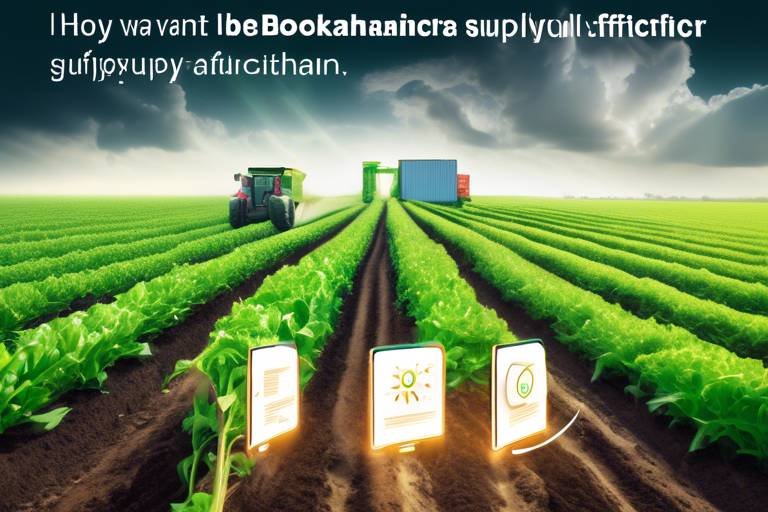The Role of Blockchain in Supporting Renewable Energy Projects
In today's rapidly evolving energy landscape, the convergence of technology and sustainability has never been more critical. As the world grapples with the pressing challenges of climate change and energy scarcity, blockchain technology emerges as a beacon of hope, illuminating the path toward a sustainable energy future. But how exactly does blockchain enhance the renewable energy sector? This article explores the multifaceted ways in which blockchain supports renewable energy projects, creating a more transparent, efficient, and trustworthy environment for all stakeholders involved.
At its core, blockchain is a decentralized ledger system that records transactions in a secure and transparent manner. Imagine a digital notebook where every transaction is recorded in ink that cannot be erased. This unique feature makes blockchain an incredibly powerful tool for various applications, particularly in the realm of renewable energy project management and trading. By eliminating the need for intermediaries, blockchain not only reduces costs but also enhances the speed and reliability of energy transactions. In essence, it transforms how energy is produced, distributed, and consumed.
One of the most significant advantages of blockchain is its ability to enhance transparency in energy transactions. With blockchain, every transaction is recorded on a public ledger that is accessible to all stakeholders. This means that anyone can verify energy transactions, fostering a sense of trust among participants in the renewable energy market. For instance, when a solar panel owner sells excess energy back to the grid, the transaction is recorded in real-time, making it virtually impossible to commit fraud. This transparency not only protects consumers but also ensures that renewable energy credits are accurately tracked and traded.
Imagine a world where you could buy and sell energy just like you trade stocks. Blockchain enables peer-to-peer energy trading, allowing consumers to engage directly in the energy market. This decentralized approach empowers individuals and communities to take control of their energy consumption and production. For example, a household with solar panels can sell surplus energy to their neighbors, creating a localized energy economy. This not only reduces reliance on traditional energy providers but also encourages investment in renewable energy sources, ultimately contributing to a more sustainable future.
Another groundbreaking feature of blockchain is the use of smart contracts. These self-executing contracts automate processes within renewable energy projects, ensuring that agreements are executed automatically when predefined conditions are met. For instance, a smart contract could automatically transfer payment to a solar energy provider once energy production is verified. This reduces administrative costs and minimizes the risk of human error, streamlining energy transactions and enhancing overall efficiency. In a sector where time is often of the essence, smart contracts can be a game changer.
The transparency and security provided by blockchain can significantly boost investment in renewable energy projects. Investors are more likely to contribute to projects that offer clear, verifiable data on performance and financial transactions. By providing a secure platform for transactions, blockchain helps to build confidence among investors. Increased investment is crucial for scaling up sustainable energy initiatives globally, and blockchain can play a pivotal role in attracting the necessary funding.
Data is the backbone of any successful renewable energy project, and blockchain enhances both data security and management. With blockchain, energy data can be securely shared among stakeholders, which is vital for monitoring, reporting, and optimizing energy production and consumption. This secure sharing of data not only improves operational efficiency but also helps in regulatory compliance, ensuring that renewable energy projects adhere to legal standards.
Despite its potential, blockchain is not without challenges. Issues such as scalability, high energy consumption, and regulatory hurdles can hinder its widespread adoption in the renewable energy sector. For instance, the energy required to maintain blockchain networks can sometimes outweigh the benefits. Addressing these limitations is essential for ensuring that blockchain can fulfill its promise in transforming the energy landscape.
Several successful case studies highlight the practical applications of blockchain in renewable energy projects. For example, a recent pilot project in Australia demonstrated how blockchain can facilitate peer-to-peer energy trading among households, resulting in increased energy efficiency and reduced costs. These examples showcase innovative solutions that not only benefit individual participants but also contribute to the broader goal of sustainability.
The future of blockchain in renewable energy looks promising, with ongoing advancements in technology and a growing global focus on sustainability. As more stakeholders recognize the benefits of blockchain, its role in transforming the energy sector will continue to evolve and expand. From enhancing transparency to boosting investment, blockchain is poised to become an integral part of the renewable energy landscape.
- What is blockchain technology? Blockchain is a decentralized ledger that records transactions securely and transparently.
- How does blockchain enhance transparency in energy transactions? It provides an immutable record of transactions that can be verified by all stakeholders.
- What are smart contracts? Smart contracts are self-executing contracts that automate processes when certain conditions are met.
- What challenges does blockchain face in the renewable energy sector? Scalability, energy consumption, and regulatory hurdles are some of the key challenges.

Understanding Blockchain Technology
Blockchain technology is like a digital ledger that keeps track of transactions in a way that is both secure and transparent. Imagine a notebook where every page is filled with records of transactions, and once something is written down, it cannot be erased or altered. This is the essence of blockchain: a decentralized system where multiple copies of the ledger exist across numerous computers, ensuring that everyone has access to the same information. In the context of renewable energy, this technology has the potential to revolutionize how we manage and trade energy resources.
At its core, blockchain operates on a network of computers, known as nodes, that communicate with each other to validate transactions. When someone wants to make a transaction, it is grouped with others into a "block." This block is then added to a "chain" of previous transactions, hence the name blockchain. The beauty of this system lies in its decentralization; there’s no single point of failure, making it incredibly resilient against fraud and hacking attempts. Each transaction is time-stamped and linked to the previous one, creating an unbreakable chain of data that is visible to all participants in the network.
One of the most exciting aspects of blockchain is its transparency. Since all transactions are recorded on a public ledger, anyone can verify the authenticity of the data. This feature is particularly beneficial in renewable energy projects, where trust among stakeholders is paramount. For instance, if a solar energy provider sells energy to a consumer, both parties can see the transaction history, ensuring that the energy sold was produced and purchased ethically. This level of transparency is crucial for building confidence in renewable energy markets, which have sometimes been marred by skepticism and fraud.
Blockchain also supports the concept of smart contracts, which are self-executing contracts with the terms of the agreement directly written into code. These contracts automatically execute actions when predefined conditions are met. For example, in a renewable energy project, a smart contract could be set up to automatically transfer payment to a solar panel owner once energy production is verified. This not only streamlines processes but also significantly reduces administrative costs and the potential for human error.
Furthermore, the application of blockchain in renewable energy is not just limited to trading; it extends to data management as well. With the increasing integration of IoT (Internet of Things) devices in energy systems, blockchain can securely manage the vast amounts of data generated. This ensures that energy production and consumption can be monitored and optimized efficiently.
In summary, understanding blockchain technology is crucial for grasping its potential impact on renewable energy. By enhancing transparency, enabling smart contracts, and providing secure data management, blockchain stands out as a game-changer. As we delve deeper into its applications and benefits, it becomes clear that this technology is paving the way for a more sustainable and trustworthy energy future.

Enhancing Transparency in Energy Transactions
In the world of renewable energy, transparency is not just a buzzword; it's a necessity. Imagine a scenario where every transaction related to energy generation and consumption is recorded in a way that everyone can see and verify. This is where blockchain technology comes into play. By creating an immutable and transparent ledger of energy transactions, blockchain fosters a level of trust that was previously hard to achieve in the renewable energy sector.
One of the most significant benefits of using blockchain for energy transactions is its ability to provide a clear audit trail. Each transaction is time-stamped and linked to the previous one, creating a chain of records that cannot be altered retroactively. This means that if a dispute arises over energy trading, stakeholders can refer back to the blockchain to see exactly what happened. It’s like having a referee in a game who can provide instant replay evidence!
Moreover, the transparency brought by blockchain helps to combat fraud, a persistent issue in the energy market. With traditional systems, it's often challenging to track the origin of energy sources, leading to potential misrepresentation. However, with blockchain, every unit of energy can be traced back to its source, whether it’s a solar panel on a rooftop or a wind turbine in a field. This traceability ensures that consumers are purchasing genuine renewable energy, thereby increasing their confidence in the market.
To illustrate the impact of blockchain on transparency, consider the following table that outlines how traditional energy transactions compare to blockchain-enabled transactions:
| Aspect | Traditional Energy Transactions | Blockchain-Enabled Transactions |
|---|---|---|
| Transaction Visibility | Limited visibility; often opaque | Full visibility; transparent |
| Fraud Prevention | Susceptible to fraud | Immutable records reduce fraud |
| Audit Trail | Difficult to track | Clear and accessible |
| Consumer Trust | Lower trust levels | Higher trust levels |
This transparency not only benefits consumers but also encourages more stakeholders to enter the renewable energy market. When investors see a system that is open and accountable, they are more likely to invest their resources. This influx of investment can lead to increased innovation and the development of more robust renewable energy projects.
In summary, blockchain technology is revolutionizing the way energy transactions are conducted by enhancing transparency. With its ability to provide a secure, immutable record of transactions, blockchain not only builds trust among stakeholders but also paves the way for a more efficient and fraud-resistant energy market. As we continue to explore the integration of blockchain in renewable energy, it becomes clear that transparency is just the tip of the iceberg.
- What is blockchain technology? Blockchain is a decentralized digital ledger that records transactions across many computers in a way that the registered transactions cannot be altered retroactively.
- How does blockchain enhance transparency? Blockchain provides a clear and immutable record of transactions, allowing all stakeholders to verify and trust the data without the need for intermediaries.
- Can blockchain help reduce energy fraud? Yes, by ensuring that every transaction is traceable and transparent, blockchain significantly reduces opportunities for fraud in energy markets.
- What are the benefits of using blockchain in renewable energy? Benefits include improved transparency, enhanced trust, reduced fraud, and increased investment in renewable energy projects.

Decentralized Energy Trading Platforms
In the rapidly evolving landscape of renewable energy, have emerged as a groundbreaking solution. Imagine a world where your solar panels not only power your home but also allow you to sell excess energy directly to your neighbor. This is no longer just a dream; it’s the reality enabled by blockchain technology. By removing the middleman, these platforms empower individuals and communities to engage in energy trading, fostering a more sustainable and self-sufficient energy ecosystem.
At the heart of decentralized trading is the concept of peer-to-peer (P2P) energy exchanges. These platforms leverage blockchain to facilitate direct transactions between energy producers and consumers, ensuring that every kilowatt hour is accounted for and that participants receive fair compensation. This not only enhances the efficiency of energy distribution but also encourages more homeowners to invest in renewable sources like solar and wind. After all, who wouldn’t want to turn their roof into a mini power plant?
One of the most significant advantages of these platforms is their ability to create a local energy market. Communities can harness their collective renewable resources, reducing dependence on traditional energy providers. For instance, a neighborhood with several homes equipped with solar panels can form a microgrid, allowing them to share energy seamlessly. This not only promotes sustainability but also enhances resilience against power outages and fluctuating energy prices.
However, the implementation of decentralized energy trading platforms is not without its challenges. Regulatory frameworks need to adapt to accommodate these new models, ensuring that all participants are protected and that the systems operate fairly. Additionally, technical hurdles such as ensuring the reliability and security of transactions must be addressed. Yet, despite these challenges, the potential benefits are undeniable.
To illustrate the impact of decentralized energy trading, let’s take a look at a few examples:
| Platform | Location | Key Features |
|---|---|---|
| Power Ledger | Australia | P2P trading, energy tracking, and carbon credits |
| WePower | Europe | Tokenized energy trading and long-term contracts |
| Brooklyn Microgrid | USA | Community-driven energy sharing and local transactions |
These platforms not only demonstrate the feasibility of decentralized energy trading but also highlight the innovative solutions emerging within the renewable energy sector. As more communities adopt these technologies, we can expect to see a significant shift in how energy is produced, consumed, and traded.
In conclusion, decentralized energy trading platforms represent a revolutionary shift in the renewable energy landscape. By enabling direct exchanges between consumers and producers, these platforms foster greater engagement and sustainability. As we continue to innovate and adapt, the future of energy trading looks brighter than ever. So, are you ready to participate in this energy revolution?
1. What are decentralized energy trading platforms?
Decentralized energy trading platforms are systems that allow consumers and producers of renewable energy to trade energy directly with one another, often using blockchain technology to facilitate secure and transparent transactions.
2. How does peer-to-peer energy trading work?
In peer-to-peer energy trading, individuals can buy and sell excess energy directly to one another without the need for traditional energy suppliers, often using smart contracts to automate the process.
3. What are the benefits of decentralized energy trading?
The benefits include increased efficiency, lower costs, enhanced sustainability, and the empowerment of local communities to manage their energy resources.
4. Are there any challenges associated with decentralized energy trading?
Yes, challenges include regulatory hurdles, the need for reliable technology, and ensuring fair access and protection for all participants.

Smart Contracts for Automation
Imagine a world where agreements are executed automatically, without the need for intermediaries. This is the promise of smart contracts, a revolutionary feature of blockchain technology that is transforming the renewable energy sector. Smart contracts are self-executing contracts with the terms of the agreement directly written into code. They run on the blockchain, making them secure, transparent, and immutable. This means that once a smart contract is deployed, it cannot be altered, ensuring that all parties adhere to the agreed-upon terms.
In the context of renewable energy, smart contracts can streamline various processes, from energy trading to project financing. For instance, when a solar panel owner generates excess energy, a smart contract can automatically sell this energy to a neighbor without the need for a middleman. The transaction is recorded on the blockchain, providing a transparent and tamper-proof history of the exchange. This not only speeds up the transaction process but also reduces costs associated with traditional energy trading methods.
Furthermore, smart contracts can facilitate automated payments. Imagine a scenario where a wind farm produces energy that is fed into the grid. A smart contract can be programmed to release payments to the wind farm operator as soon as the energy is delivered. This eliminates delays and disputes, ensuring that operators are paid promptly for their contributions to the energy supply. The automation of these processes not only enhances efficiency but also builds trust among stakeholders, as everyone can verify transactions in real-time.
Here are some key benefits of using smart contracts in renewable energy:
- Efficiency: Automating transactions reduces the time and effort required to manage contracts manually.
- Cost-effectiveness: By cutting out intermediaries, smart contracts lower transaction costs.
- Transparency: All parties can view the contract and its execution, fostering trust and accountability.
- Security: The decentralized nature of blockchain ensures that contracts are secure and tamper-proof.
However, it's crucial to recognize that while smart contracts offer significant advantages, they are not without challenges. The complexity of coding these contracts can lead to vulnerabilities if not done correctly. Additionally, the legal recognition of smart contracts varies by jurisdiction, and there may be regulatory hurdles to navigate. Despite these challenges, the potential for smart contracts to revolutionize the renewable energy sector is immense. As technology advances, we can expect to see more innovative applications that harness the power of automation to drive the transition to sustainable energy.
What are smart contracts?
Smart contracts are self-executing contracts with the terms of the agreement directly written into code and run on a blockchain.
How do smart contracts enhance renewable energy transactions?
They automate processes, reduce costs, and ensure transparency and security in energy trading and project management.
Are there any challenges associated with smart contracts?
Yes, challenges include coding complexity, legal recognition, and regulatory hurdles that need to be addressed for widespread adoption.

Boosting Investment in Renewable Projects
This article explores how blockchain technology enhances transparency, efficiency, and trust in renewable energy initiatives, paving the way for a sustainable energy future.
Blockchain is a decentralized ledger system that records transactions securely and transparently. Its unique features make it a powerful tool for various applications, including renewable energy project management and trading.
Blockchain improves transparency by providing a clear and immutable record of energy transactions. This fosters trust among stakeholders and helps prevent fraud in renewable energy markets.
Blockchain enables peer-to-peer energy trading, allowing consumers to buy and sell renewable energy directly. This decentralized approach empowers individuals and communities to participate actively in the energy market.
Smart contracts automate processes in renewable energy projects, ensuring that agreements are executed automatically when conditions are met. This reduces administrative costs and enhances efficiency in energy transactions.
One of the most exciting aspects of blockchain technology is its potential to boost investment in renewable energy projects. By providing a transparent and secure platform for transactions, blockchain can attract more investors who are often wary of the complexities and risks associated with traditional energy markets. Imagine a world where investors can easily verify the legitimacy of a project and its projected returns without the typical red tape. This is where blockchain shines.
Investors today are looking for assurance and clarity before committing their funds. Blockchain offers a solution by creating an immutable record of all transactions related to a renewable energy project. This means that every investment, every transaction, and every contract is securely documented and easily accessible. With this level of transparency, investors can confidently assess the viability of projects, knowing they have access to accurate and real-time information.
Furthermore, blockchain can facilitate fractional ownership of renewable energy assets. This means that smaller investors can buy shares in larger projects, significantly lowering the barrier to entry. For instance, a solar farm that costs millions to build could be funded by hundreds of small investors, each contributing a fraction of the total cost. This democratization of investment not only opens up new opportunities for individual investors but also diversifies the funding sources for renewable energy projects.
Additionally, the use of blockchain can streamline the fundraising process. Traditional methods often involve lengthy due diligence and complex paperwork. In contrast, blockchain can automate many of these processes through smart contracts, which execute agreements automatically when predetermined conditions are met. This not only saves time but also reduces administrative costs, making projects more attractive to potential investors.
However, while the potential is enormous, it’s essential to recognize that the integration of blockchain in renewable energy investment is still in its infancy. Challenges such as regulatory uncertainties and the need for industry standards must be addressed to fully realize its potential. Investors will need to be educated on how blockchain works and its benefits in the renewable energy sector.
Blockchain enhances data security and management in renewable energy systems. It allows for secure sharing of energy data, which is vital for monitoring, reporting, and optimizing energy production and consumption.
Despite its potential, blockchain faces challenges such as scalability, energy consumption, and regulatory hurdles. Addressing these limitations is essential for the widespread adoption of blockchain in renewable energy.
Several successful case studies demonstrate the practical applications of blockchain in renewable energy projects. These examples highlight innovative solutions and the benefits realized by implementing blockchain technology.
The future of blockchain in renewable energy looks promising, with ongoing advancements in technology and increasing global focus on sustainability. Its role in transforming the energy sector will continue to evolve and expand.
- What is blockchain technology? - Blockchain is a decentralized digital ledger that securely records transactions across many computers.
- How does blockchain improve transparency in renewable energy? - It provides an immutable record of transactions, fostering trust and reducing fraud.
- Can blockchain help in peer-to-peer energy trading? - Yes, it enables consumers to buy and sell renewable energy directly, enhancing market participation.
- What are smart contracts? - Smart contracts are self-executing contracts with the terms directly written into code, automating processes in energy transactions.
- What challenges does blockchain face in renewable energy? - Challenges include scalability, energy consumption, and regulatory issues that need to be addressed for widespread adoption.

Energy Data Management and Security
In today's fast-paced world, where data is generated at an unprecedented rate, managing energy data effectively is crucial for optimizing renewable energy systems. Blockchain technology stands out as a game-changer in this arena, offering a secure and transparent way to handle energy data. Imagine a digital vault where every transaction is recorded, verified, and immutable—this is what blockchain provides. By utilizing a decentralized ledger, stakeholders can access real-time data without the fear of tampering or unauthorized alterations.
One of the most significant advantages of blockchain in energy data management is its ability to enhance security. Traditional data management systems often suffer from vulnerabilities, making them susceptible to hacks and data breaches. In contrast, blockchain's cryptographic features ensure that data is not only secure but also easily traceable. Each block in the chain contains a unique cryptographic hash of the previous block, creating a robust link that makes it nearly impossible to alter any information without detection. This level of security fosters trust among consumers, producers, and regulators alike.
Moreover, blockchain facilitates better data sharing among various participants in the renewable energy sector. For instance, energy producers can securely share their production data with grid operators, while consumers can access their consumption data without compromising their privacy. This transparent sharing of information leads to improved decision-making and more efficient energy distribution. With blockchain, the energy market can move towards a more collaborative approach, where all parties work together to optimize energy production and consumption.
To illustrate the impact of blockchain on energy data management and security, consider the following table that compares traditional data management systems with blockchain-based systems:
| Feature | Traditional Systems | Blockchain Systems |
|---|---|---|
| Data Security | Vulnerable to hacks and breaches | Highly secure with cryptographic methods |
| Data Transparency | Limited access and visibility | Open and accessible to authorized users |
| Data Integrity | Prone to alterations | Immutable records ensure data integrity |
| Data Sharing | Complex and often inefficient | Streamlined and efficient peer-to-peer sharing |
In summary, the integration of blockchain technology into energy data management not only enhances security but also promotes transparency and collaboration within the renewable energy sector. As we continue to embrace sustainable energy solutions, leveraging blockchain for data management will be crucial in ensuring a reliable and efficient energy future.
- What is blockchain technology? Blockchain is a decentralized ledger system that securely records transactions across multiple computers, ensuring that the data cannot be altered retroactively.
- How does blockchain enhance data security? Blockchain uses cryptographic techniques to secure data, making it nearly impossible for unauthorized parties to alter or access sensitive information.
- Can blockchain improve energy trading? Yes, blockchain enables peer-to-peer energy trading, allowing consumers to buy and sell renewable energy directly, which promotes market efficiency.
- What are smart contracts? Smart contracts are self-executing contracts with the terms of the agreement directly written into code, allowing for automated and secure transactions.

Challenges and Limitations of Blockchain
While blockchain technology offers a revolutionary approach to managing renewable energy projects, it is not without its challenges and limitations. One of the most significant issues is scalability. As blockchain networks grow, the volume of transactions can overwhelm the system, leading to slower processing times and increased fees. Imagine trying to fit a large crowd into a small room; the more people you add, the more chaotic and inefficient things become. This scalability issue can hinder the widespread adoption of blockchain in the renewable energy sector.
Another critical limitation is the energy consumption associated with blockchain operations, particularly those that rely on proof-of-work consensus mechanisms. The irony is palpable: a technology designed to promote sustainability can, in some cases, consume vast amounts of energy itself. This raises questions about the environmental impact of blockchain systems, especially when they are used to support renewable energy initiatives.
Furthermore, there are regulatory hurdles that must be navigated. Governments and regulatory bodies are still figuring out how to classify and regulate blockchain technology within the energy sector. This uncertainty can deter potential investors and innovators from fully committing to blockchain solutions. Without clear guidelines, many companies may hesitate to adopt blockchain, fearing potential legal ramifications down the line. For instance, if a company invests heavily in a blockchain solution only to find out it doesn’t comply with local regulations, it could face hefty fines or even be forced to shut down operations.
Additionally, the interoperability of different blockchain systems poses another challenge. With multiple blockchain platforms available, ensuring they can communicate and work together seamlessly is crucial for creating a cohesive energy market. Think of it like trying to connect different brands of smartphones; if they don’t speak the same language, sharing data becomes a nightmare.
Despite these challenges, the potential benefits of blockchain in renewable energy are undeniable. Addressing these limitations will require collaboration between technology developers, energy companies, and regulatory bodies. By working together, stakeholders can create solutions that enhance the capabilities of blockchain while minimizing its drawbacks. The journey may be complex, but the destination—a sustainable energy future powered by innovative technology—is worth the effort.
- What is blockchain technology?
Blockchain is a decentralized ledger system that records transactions securely and transparently, making it an effective tool for various applications, including renewable energy.
- How does blockchain enhance transparency in energy transactions?
Blockchain provides a clear and immutable record of energy transactions, fostering trust among stakeholders and helping to prevent fraud.
- What are smart contracts?
Smart contracts are self-executing agreements with the terms directly written into code, automating processes in renewable energy projects.
- What challenges does blockchain face in the renewable energy sector?
Challenges include scalability, energy consumption, regulatory hurdles, and interoperability between different blockchain systems.

Case Studies of Blockchain in Renewable Energy
When it comes to real-world applications of blockchain technology in renewable energy, there are some fascinating case studies that exemplify its potential. One of the most notable examples is the Power Ledger project in Australia. This platform allows homeowners with solar panels to sell excess energy directly to their neighbors, creating a decentralized energy trading system. By using blockchain, Power Ledger ensures that every transaction is recorded transparently and securely, fostering trust among participants. This not only empowers consumers but also encourages the adoption of renewable energy sources.
Another exciting case study can be found in the Brooklyn Microgrid initiative. This project enables residents in Brooklyn to generate, sell, and buy renewable energy from one another using blockchain technology. The microgrid operates on a peer-to-peer energy trading model, where participants can track their energy production and consumption in real-time. The use of blockchain not only enhances transparency but also allows for a more resilient energy system, as it reduces dependency on traditional energy suppliers.
Moreover, in Europe, the WePower platform is revolutionizing how renewable energy is financed. By tokenizing energy, WePower allows producers to sell their energy in advance to consumers and investors using blockchain. This innovative approach not only provides liquidity for renewable energy projects but also increases investment opportunities. The smart contracts embedded in the blockchain automate transactions, ensuring that energy is delivered as promised, thereby reducing risks for both producers and consumers.
To illustrate these case studies further, here’s a table summarizing key features and benefits:
| Project | Location | Key Features | Benefits |
|---|---|---|---|
| Power Ledger | Australia | Peer-to-peer energy trading | Empowers consumers, promotes solar energy usage |
| Brooklyn Microgrid | USA | Community-based energy trading | Enhances energy resilience, builds community |
| WePower | Europe | Tokenized energy contracts | Increases investment, reduces risks |
These examples demonstrate that blockchain is not just a buzzword; it is a transformative technology that is reshaping the renewable energy landscape. By facilitating decentralized energy trading, enhancing transparency, and automating processes, blockchain is paving the way for a more sustainable energy future. As these case studies show, the benefits of blockchain in renewable energy projects are vast, and we can expect to see even more innovative applications emerge in the coming years.
What is blockchain technology?
Blockchain is a decentralized ledger system that securely records transactions across multiple computers, ensuring that the record cannot be altered retroactively without the consensus of the network.
How does blockchain enhance renewable energy projects?
Blockchain enhances renewable energy projects by providing transparency, enabling peer-to-peer trading, automating processes through smart contracts, and improving data security.
Are there any challenges to implementing blockchain in renewable energy?
Yes, challenges include scalability issues, high energy consumption of some blockchain networks, and regulatory hurdles that need to be addressed for broader adoption.
Can blockchain help reduce energy costs?
Absolutely! By enabling direct transactions between energy producers and consumers, blockchain can lower costs associated with intermediaries and enhance market efficiency.

The Future of Blockchain in Renewable Energy
The future of blockchain technology in renewable energy is not just bright; it's practically glowing with potential! As we stand on the brink of a new energy era, the integration of blockchain into renewable projects is set to revolutionize how we generate, trade, and consume energy. Imagine a world where energy transactions are seamless, transparent, and completely trustworthy—this is what blockchain promises. With the global push towards sustainability, the role of blockchain in enhancing the efficiency and accessibility of renewable energy sources is becoming increasingly crucial.
One of the most exciting aspects of this technology is its ability to facilitate decentralized energy systems. In the near future, we could see communities empowered to produce their own energy, trading excess power with neighbors through blockchain-enabled platforms. This shift not only fosters local energy independence but also promotes a sense of community. Just think about it: your solar panels could not only power your home but also contribute to your neighbor's energy needs, all while you earn credits through a smart contract!
Moreover, advancements in smart contracts will further streamline processes in renewable energy projects. These self-executing contracts ensure that agreements are automatically fulfilled when conditions are met, minimizing the need for intermediaries and reducing costs. The automation of these processes will lead to faster transactions and increased trust among participants. As we embrace this technology, the energy sector will likely witness a significant reduction in operational inefficiencies.
However, the journey towards a fully integrated blockchain system in renewable energy isn't without its hurdles. Issues such as regulatory challenges and concerns over energy consumption associated with blockchain operations need to be addressed. Policymakers and industry leaders must collaborate to create frameworks that support innovation while ensuring sustainability. The good news? Many stakeholders are already working together to tackle these challenges, paving the way for a smoother transition.
In conclusion, the future of blockchain in renewable energy is not just a possibility; it’s an inevitable evolution. As technology continues to advance and the world becomes more committed to sustainable practices, we can expect to see blockchain playing a pivotal role in transforming the energy landscape. The synergy between blockchain and renewable energy could lead to a more decentralized, efficient, and transparent energy future, making it an exciting time for both the tech and energy sectors.
- What is blockchain technology?
Blockchain is a decentralized digital ledger that records transactions across many computers securely and transparently.
- How does blockchain enhance transparency in renewable energy?
It provides an immutable record of transactions, fostering trust among stakeholders and reducing fraud.
- Can individuals trade energy using blockchain?
Yes! Blockchain enables peer-to-peer energy trading, allowing consumers to buy and sell renewable energy directly.
- What are smart contracts?
Smart contracts are self-executing contracts with the terms of the agreement directly written into code, automating processes in energy transactions.
- What challenges does blockchain face in renewable energy?
Challenges include scalability, energy consumption, and regulatory hurdles that need to be addressed for widespread adoption.
Frequently Asked Questions
- What is blockchain technology?
Blockchain technology is a decentralized ledger system that securely records transactions across multiple computers. This means that once a transaction is recorded, it cannot be altered retroactively, ensuring transparency and security. It's like having a public notebook where everyone can see what’s written, but no one can erase or change anything.
- How does blockchain enhance transparency in renewable energy transactions?
Blockchain enhances transparency by providing an immutable record of all energy transactions. This means that every time energy is bought or sold, it gets logged in a way that everyone can see and verify, which builds trust among all parties involved. Think of it as a glass box where all transactions are visible, preventing any shady dealings.
- What are decentralized energy trading platforms?
Decentralized energy trading platforms allow consumers to buy and sell renewable energy directly from one another without the need for a middleman. This peer-to-peer model empowers individuals to engage actively in the energy market, much like how a farmer sells fresh produce directly to consumers at a local market.
- What are smart contracts and how do they work in renewable energy projects?
Smart contracts are self-executing contracts with the terms of the agreement directly written into code. In renewable energy projects, they automate processes like payment transfers or energy credits, executing automatically when predefined conditions are met. Imagine a vending machine: you put in money, select your item, and it automatically delivers it without needing anyone to intervene.
- Can blockchain attract more investment in renewable energy?
Absolutely! By providing a secure and transparent platform for transactions, blockchain can make renewable energy projects more appealing to investors. When investors see a clear and trustworthy system, they are more likely to put their money into these projects, similar to how a well-documented business plan can attract investors in any industry.
- How does blockchain improve energy data management and security?
Blockchain enhances energy data management by allowing secure sharing and storage of data related to energy production and consumption. This is crucial for monitoring and optimizing energy systems. Think of it as a secure vault for energy data that only authorized users can access, ensuring that sensitive information remains protected.
- What challenges does blockchain face in the renewable energy sector?
Despite its potential, blockchain faces several challenges, including scalability issues, high energy consumption, and regulatory hurdles. These challenges need to be addressed to ensure widespread adoption. It’s like trying to fit a square peg into a round hole; if the conditions aren’t right, it won’t work effectively.
- Are there any successful case studies of blockchain in renewable energy?
Yes, there are several successful case studies showcasing how blockchain has been implemented in renewable energy projects. These examples illustrate innovative solutions and the tangible benefits that come from using this technology, much like success stories that inspire others to follow suit.
- What does the future hold for blockchain in renewable energy?
The future of blockchain in renewable energy looks bright, with ongoing advancements in technology and a growing global focus on sustainability. As more people recognize its potential, we can expect to see its role in transforming the energy sector continue to evolve and expand, much like how smartphones revolutionized communication.



















